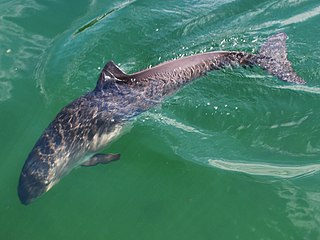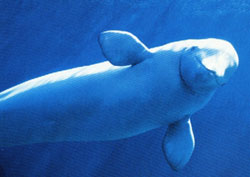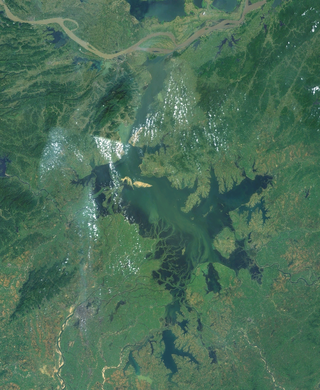Narrow-ridged finless porpoise may refer to one of two species in the genus Neophocaena:
- the East Asian finless porpoise (N. sunameri)
- the Yangtze finless porpoise (N. asiaeorientalis)
Narrow-ridged finless porpoise may refer to one of two species in the genus Neophocaena:

Porpoises are small cetaceans classified under the family Phocoenidae. Although similar in appearance to dolphins, they are more closely related to narwhals and belugas than to the true dolphins. There are eight extant species of porpoise, all among the smallest of the toothed whales. Porpoises are distinguished from dolphins by their flattened, spade-shaped teeth distinct from the conical teeth of dolphins, and lack of a pronounced beak, although some dolphins also lack a pronounced beak. Porpoises, and other cetaceans, belong to the clade Cetartiodactyla with even-toed ungulates.

The cetacean family Monodontidae comprises two living whale species, the narwhal and the beluga whale and at least four extinct species, known from the fossil record. Beluga and Narwhal are native to coastal regions and pack ice around the Arctic Ocean. Both species are relatively small whales, between three and five metres in length, with a forehead melon, and a short or absent snout. They do not have a true dorsal fin, but do have a narrow ridge running along the back, which is much more pronounced in the narwhal. They are highly vocal animals, communicating with a wide range of sounds. Like other whales, they also use echolocation to navigate. Belugas can be found in the far north of the Atlantic and Pacific Oceans; the distribution of narwhals is restricted to the Arctic and Atlantic Oceans.

Dongting Lake is a large, shallow lake in northeastern Hunan Province, China. It is a flood basin of the Yangtze River, so its volume depends on the season. The provinces of Hubei and Hunan are named after their location relative to the lake: Hubei means "North of the Lake" and Hunan, "South of the Lake".

The Indo-Pacific finless porpoise is one of eight porpoise species. The species ranges throughout most of the Indian Ocean, as well as the tropical and subtropical Pacific from Indonesia north to the Taiwan Strait. Overlapping with this species in the Taiwan Strait and replacing it northwards is the East Asian finless porpoise.

Neophocaena is a genus of porpoise native to the Indian and Pacific oceans, as well as the freshwater habitats of the Yangtze River basin in China. They are commonly known as finless porpoises. Genetic studies indicate that Neophocaena is the most basal living member of the porpoise family.

Poyang Lake, located in Jiujiang, is the largest freshwater lake in China.

The Institute of Hydrobiology, Chinese Academy of Sciences is a research institute located in Wuhan, Hubei, China. It was founded in 1950 and specializes in freshwater organisms. It is involved in the study of the finless porpoise and the now extinct baiji dolphin. China Zebrafish Resource Center is housed in the institute campus.

Phang Nga Bay is a 400 km2 (150 sq mi) bay in the Andaman Sea between the island of Phuket and the mainland of the Kra Isthmus of southern Thailand. Since 1981, an extensive section of the bay has been protected as the Ao Phang Nga National Park. The park is in Phang Nga Province, at 8°17′N98°36′E.

Tong Fuk Beach is a gazetted beach located on South Lantau Road in Tong Fuk, Lantau Island, Hong Kong. The beach is managed by the Leisure and Cultural Services Department of the Hong Kong Government. The beach is 150 metres long and is rated as good to fair by the Environmental Protection Department for its water quality in the past twenty years. It is a popular holiday resort in Lantau Island.
The Tian-e-Zhou Oxbow Nature Reserve is an area of wetland in the Yangtze basin near Shishou, Hubei province, People's Republic of China. Inside the reserve is the Tian'e-Zhou lake which was an intended sanctuary for the baiji and is currently holding 28 finless porpoises.

Miyajima Public Aquarium is an aquarium on the island of Itsukushima in Hatsukaichi, Hiroshima, Japan.

The baiji is a possibly extinct species of freshwater dolphin native to the Yangtze river system in China. It is thought to be the first dolphin species driven to extinction due to the impact of humans. This dolphin is listed as “critically endangered: possibly extinct” by the IUCN, has not been seen in 40 years, and several surveys of the Yangtze have failed to find it. In China, the species is also called the Chinese river dolphin, Han river dolphin, Yangtze dolphin and whitefin dolphin. Nicknamed the "Goddess of the Yangtze", it was regarded as the goddess of protection by local fishermen and boatmen. It is not to be confused with the Chinese white dolphin or the finless porpoise. This is the only species in the genus Lipotes.

Toba Aquarium is a public aquarium, which is located in Toba, Mie, Japan. The aquarium houses 12 zones which reproduce natural environments, housing some 25,000 individuals representing 1,200 species.

The East Asian finless porpoise is a species of porpoise native to the East China Sea, Yellow Sea, and the seas around Japan. The Yangtze finless porpoise was formerly considered a subspecies, but is now thought to be a distinct species.

Upper Cheung Sha Beach is a gazetted beach in Cheung Sha in southern Lantau Island, Hong Kong. The beach has barbecue pits and is managed by the Leisure and Cultural Services Department of the Hong Kong Government. The beach is rated as good to fair by the Environmental Protection Department for its water quality in the past twenty years. It is still the longest beach in Hong Kong.
Brauninidae is a monotypic family of trematodes in the order Diplostomida. It consists of one genus, Braunina Heider, 1900, which consists of one species, Braunina cordiformis Wolf, 1903.

The Yangtze finless porpoise is a species of toothed whale in the family Phocoenidae. It is endemic to the Yangtze River in China, making it the country's only known freshwater cetacean following the possible extinction of the baiji. The Yangtze finless porpoise is considered critically endangered and it is estimated that only about 1,000 remain. This small toothed whale faces many of the same threats that caused the baiji dolphin to possibly become extinct. The Yangtze River has a high traffic rate of human activity causing population declines due to illegal fishing, pollution, vessel traffic, and dam construction. Due to the rapidly declining population of the species, the Chinese Government and conservation charities are working to help save it from extinction.

The Karry Porpoise is an electric light, commercial 4-door van designed and produced by the Chinese automaker Karry since June 2022.